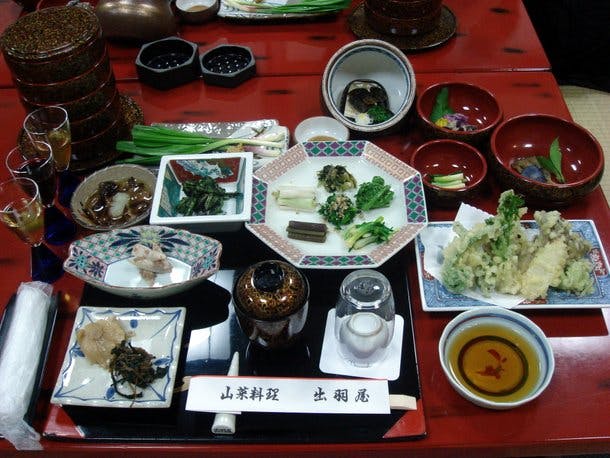
seaweed of the forest
Read about Dewaya restaurant, located at the base of Mount Gasson in Yamagata Prefecture, Japan. Discover the unique cuisine that focuses on uncultivated vegetables and wild ingredients for an authentic Japanese dining experience.
Restaurant Dewaya, Nishikawa Town, Yamagata Prefecture (I'm sorry I can't read the address on their Japanese card, but their website is www.dewaya.com.
A Japanese chef friend in New York told me about Dewaya, a restaurant located at the foot of Mount Gasson, a holy pilgrimage destination in the Tohoku region's Yamagata Prefecture. It started 80 years ago as a rural lodge for pilgrims, but became famous for its cuisine based solely on uncultivated vegetables when one day, as the story goes, the lodge ran out of food and had to serve the pilgrims local wild greens picked from the mountains. The response was enthusiastic. A celebrated "sansai" (wild vegetable) restaurant was born.
I was extremely fortunate to have been joined by the gracious Vice Governor Gotoh-san, her assistant Sato-san, and an English professor named Simon Reeves - who all pitched in to help translate. (Thank you again!)
We met the second-generation chef and owner in the restaurant's "kura," or traditional warehouse, a two-story rectangular box built with thick packed-earth walls. This one had been converted into a private dining room. His assistant soon arrived with two bamboo trays filled with raw ingredients, and the chef -- a man passionate about his wild greens -- launched into a spirited explanation.
The chef walked us through his vegetables: wild garlic, wild wasabi, fiddlehead ferns and a dozen others, some with names only in the local dialect. Then there were mushrooms: hen-of-the-woods, shiitake, oh-shiitake ("big shiitake") and shi-shiitake -- "aroma shiitake," which the chef held up to my nose and which, yes, gave off a big, beautiful, earthy fragrance.
Everything had been picked from the particular beech forest that surrounds this restaurant, the largest concentration of beech trees in Japan - in fact, many of the ingredients were unique to just this forest. Some of them, the chef explained, were eaten fresh, others dried or salted and preserved. One green called zenmai, he said, is toxic raw, but safe to eat when dried and rehydrated, and can last for three years. I wondered about the intrepid soul who had discovered that.
The chef introduced the wild ingredient he was most proud of, a moss that grows nowhere in Japan except on the high branches of the local beech trees. "The seaweed of the forest," he announced as he explained how traditionally it could only be picked in the winter, when ten-foot snow drifts made access to those branches possible. It did indeed resemble seaweed, green and stringy, but smelled of the forest, like the mushrooms. Unlike plentiful seaweed, though, this beech moss takes a full ten years to reach maturity.
As the chef spoke, I thought about how these ingredients challenged my notions about Japanese cuisine, ideas shaped by spectacular seafood and pristine vegetables. Here in these rugged mountains, far from the sea (especially in the old days) and with limited arable land, the local people made do with what they had. And some of what they had came from foraging the beech forest. What struck me is how they - in the person of this chef - infused these singular ingredients with the same creativity and depth that makes Japanese cuisine so remarkable.
Dinner drove the point home: We were treated to an elegant 22-course wild vegetable tasting menu that included three kinds of soup and a hot pot of wild greens and amazing local chicken. The key to this sansai cookery, the server explained, was to take pleasure in the flavors in their natural state. As we sat on tatami mats with trays laid out before us, we taste bitter, sour, sweet and salty ingredients - all complemented by the local Mount Gasson sake, brewed specifically to match the food at this restaurant.
